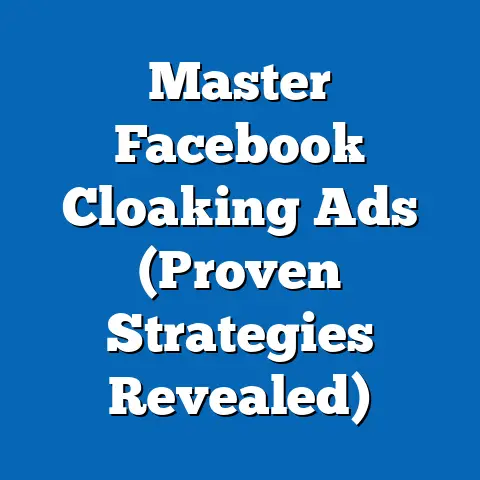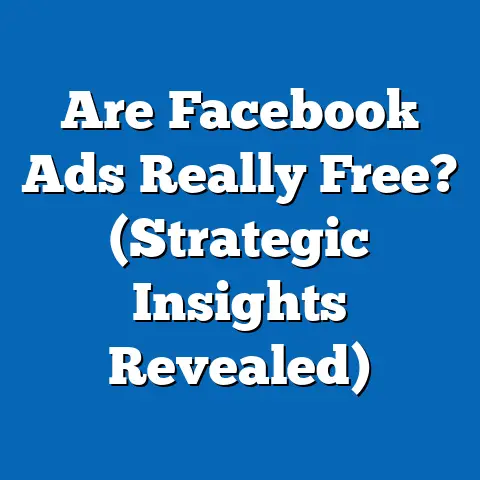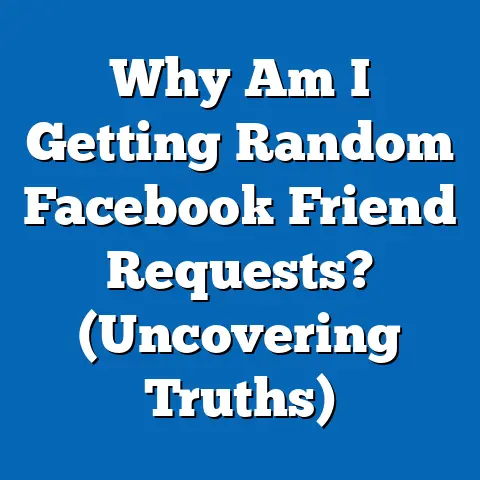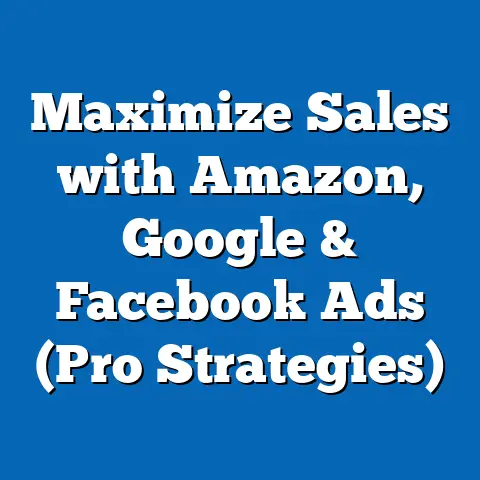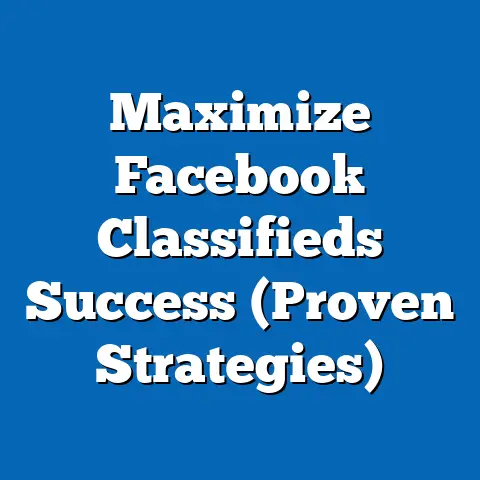Unlock Facebook Leads with Lead Ads (Proven Strategies)
In today’s fast-paced digital world, where information is at our fingertips, the health and wellness sector has seen an unprecedented boom. People are more conscious about their health than ever before, actively seeking products, services, and information to improve their well-being. As a digital marketing specialist, I’ve witnessed firsthand how businesses can leverage digital platforms to connect with this health-conscious audience. One of the most effective tools I’ve found is Facebook Lead Ads.
Why Facebook Lead Ads, you might ask? Well, they’re a game-changer, particularly for businesses in the health and wellness industry. They offer a seamless way to capture potential customers’ information directly within the Facebook platform. Imagine the possibilities – reaching individuals interested in fitness programs, nutritional supplements, mental wellness services, and more, without them ever having to leave the comfort of their Facebook feed.
Think about it: leads are the lifeblood of any business, but especially so in the health sector. Effective lead generation isn’t just about increasing sales; it’s about connecting people with the right solutions to improve their health outcomes. When you generate quality leads, you’re not just making a profit; you’re contributing to a healthier, happier society.
So, buckle up as we dive into the world of Facebook Lead Ads, exploring their unique advantages and providing you with actionable steps to create campaigns that not only generate leads but also make a positive impact on people’s lives.
Section 1: Understanding Facebook Lead Ads
What Are Facebook Lead Ads?
Facebook Lead Ads are a specialized ad format designed to collect contact information from potential customers directly within the Facebook platform. Unlike traditional ads that redirect users to an external landing page, Lead Ads allow users to submit their information without ever leaving Facebook. This streamlined process significantly reduces friction, making it easier for people to express their interest in your products or services.
Essentially, a Lead Ad consists of an engaging visual (image or video), compelling ad copy, and a call-to-action button that prompts users to fill out a form. When a user clicks the call-to-action, a pre-populated form appears, often with information Facebook already has about the user (name, email, phone number). Users can review and submit the form with just a few taps, making it incredibly convenient.
Why Lead Ads Are a Game-Changer for the Health Sector
In the health sector, trust and convenience are paramount. People are often hesitant to share personal information, especially when it comes to their health concerns. Lead Ads address this concern by providing a secure and user-friendly way to collect information within a familiar environment like Facebook.
Compared to traditional ad formats, Lead Ads offer several key advantages:
- Reduced Friction: Eliminating the need to navigate to an external landing page significantly increases conversion rates.
- Mobile-Friendly: Lead Ads are optimized for mobile devices, which is crucial considering the majority of Facebook users access the platform on their smartphones.
- Pre-Populated Forms: Facebook automatically fills in some fields, saving users time and effort.
- Customizable Forms: You can tailor the questions in your lead form to gather specific information relevant to your health services.
- Direct Integration: Seamlessly integrate leads with your CRM system for efficient follow-up.
I remember working with a local physiotherapy clinic that struggled to generate leads through their website. They were spending a fortune on SEO and traditional ads, but the results were underwhelming. After switching to Facebook Lead Ads, they saw a dramatic increase in appointment bookings. The ease of submitting information directly within Facebook made all the difference.
The User Experience: Simplicity and Convenience
From a consumer’s perspective, interacting with a Lead Ad is incredibly simple. Imagine scrolling through your Facebook feed and seeing an ad for a new fitness program. The ad features a compelling image and highlights the benefits of the program. Intrigued, you click the “Sign Up” button.
Instead of being redirected to a website, a form pops up right within Facebook, pre-filled with your name, email, and phone number. You quickly review the information, answer a few additional questions about your fitness goals, and hit “Submit.” That’s it! You’ve expressed your interest in the program without ever leaving Facebook.
This seamless experience is a major reason why Lead Ads are so effective. It eliminates the frustration of slow-loading landing pages, complicated forms, and the need to remember login details.
Statistics and Case Studies: Proving the Effectiveness
The effectiveness of Lead Ads is backed by solid data. According to Facebook, Lead Ads have been shown to generate leads at a lower cost per lead compared to traditional website-based lead generation methods.
- Lower Cost Per Lead: Businesses using Lead Ads often report a significant reduction in their cost per lead, sometimes as much as 50%.
- Increased Conversion Rates: The streamlined user experience leads to higher conversion rates, meaning more people who see your ad will actually become leads.
- Improved Lead Quality: By asking targeted questions in your lead form, you can qualify leads and ensure you’re only following up with individuals who are genuinely interested in your services.
Case Study Example: A mental wellness app used Facebook Lead Ads to generate sign-ups for their free trial. By targeting users interested in mindfulness and stress reduction, they were able to acquire high-quality leads at a cost of $5 per lead, significantly lower than their previous cost per lead of $12 through website-based ads.
Key Takeaway: Facebook Lead Ads offer a powerful and efficient way to generate leads in the health sector. Their streamlined user experience, mobile-friendly design, and customizable forms make them a valuable tool for connecting with potential customers.
Next Step: Now that you understand the basics of Lead Ads, let’s dive into the proven strategies for creating effective campaigns that drive results.
Section 2: Proven Strategies for Creating Effective Lead Ads
Creating effective Lead Ads requires a strategic approach. It’s not enough to simply throw up an ad and hope for the best. You need to craft compelling ad copy, design eye-catching visuals, target the right audience, create an irresistible offer, and build an engaging lead form. Let’s break down each of these elements in detail.
Subsection 2.1: Crafting Compelling Ad Copy
Your ad copy is the first thing people will read, so it needs to grab their attention and pique their interest. In the health sector, it’s crucial to be persuasive, informative, and empathetic. Here are some tips for writing ad copy that resonates with health-conscious audiences:
- Highlight the Benefits: Focus on the benefits of your product or service, rather than just the features. How will it improve their health, well-being, or quality of life?
- Use Strong Action Verbs: Start your sentences with action verbs like “Discover,” “Transform,” “Achieve,” or “Experience” to create a sense of urgency and excitement.
- Address Pain Points: Identify the common pain points of your target audience and explain how your product or service can solve them.
- Use Social Proof: Include testimonials, reviews, or statistics to build trust and credibility.
- Keep it Concise: Get straight to the point and avoid jargon or technical terms that your audience may not understand.
- Personalize Your Message: Use language that speaks directly to your target audience, addressing their specific needs and concerns.
Examples of Successful Ad Copy:
- Fitness Program: “Transform your body and achieve your fitness goals with our personalized workout plans. Join our community and experience the difference!”
- Nutritional Supplements: “Discover the power of natural supplements to boost your energy, improve your immunity, and enhance your overall well-being.”
- Mental Wellness App: “Reduce stress, improve your mood, and find inner peace with our guided meditation exercises. Start your free trial today!”
Why These Examples Work:
- They focus on the benefits, not just the features.
- They use strong action verbs to create a sense of urgency.
- They address common pain points (e.g., wanting to transform your body, reduce stress).
- They include a clear call-to-action (e.g., “Start your free trial today!”).
I’ve found that using a storytelling approach can also be incredibly effective. Share a brief anecdote about a customer who benefited from your product or service. This helps to humanize your brand and make your message more relatable.
Subsection 2.2: Designing Eye-Catching Visuals
Visuals play a crucial role in Lead Ads, capturing attention and conveying your message in a compelling way. Here are some tips for selecting images and videos that resonate with health-focused consumers:
- Use High-Quality Images: Opt for professional-looking images that are clear, well-lit, and visually appealing.
- Show Real People: Use images of real people using your product or service, rather than stock photos. This helps to build trust and authenticity.
- Highlight the Benefits: Choose images that visually represent the benefits of your product or service.
- Use Video: Video is a highly engaging format that can effectively convey your message and capture attention.
- Keep it Consistent: Ensure your visuals are consistent with your brand’s identity and messaging.
- Test Different Visuals: Experiment with different images and videos to see what resonates best with your target audience.
Examples of Effective Visuals:
- Fitness Program: A video showing people of different ages and body types participating in a fun and engaging workout session.
- Nutritional Supplements: An image of fresh, natural ingredients used in your supplements, highlighting their health benefits.
- Mental Wellness App: A calming and serene image of someone meditating in a peaceful setting.
Why These Examples Work:
- They are visually appealing and capture attention.
- They show real people using the product or service.
- They highlight the benefits of the product or service.
- They are consistent with the brand’s identity and messaging.
I once worked with a yoga studio that struggled to attract new students. Their initial Lead Ads featured generic stock photos of people doing yoga poses. After switching to authentic images of their actual students and instructors, they saw a significant increase in sign-ups. People were more likely to engage with visuals that felt real and relatable.
Subsection 2.3: Utilizing Targeting Options Effectively
Facebook’s targeting capabilities are incredibly powerful, allowing you to reach the right audience with your Lead Ads. Here’s how to leverage them effectively to reach health-conscious consumers:
- Demographics: Target users based on age, gender, location, education, and other demographic factors.
- Interests: Target users based on their interests, such as fitness, nutrition, healthy eating, mental wellness, and specific health conditions.
- Behaviors: Target users based on their online behavior, such as purchasing habits, website visits, and engagement with health-related content.
- Custom Audiences: Create custom audiences based on your existing customer data, such as email lists or website visitors.
- Lookalike Audiences: Create lookalike audiences based on your custom audiences, targeting users who share similar characteristics and behaviors.
Insights for Creating Custom and Lookalike Audiences:
- Website Visitors: Target users who have visited specific pages on your website, such as your services page or blog posts about health topics.
- Email Subscribers: Upload your email list to Facebook and create a custom audience of your subscribers.
- Engaged Users: Target users who have engaged with your Facebook page, such as liking your posts, watching your videos, or commenting on your content.
I’ve found that creating lookalike audiences based on your most loyal customers can be incredibly effective. These users are likely to share similar characteristics and interests with your existing customers, making them highly qualified leads.
Subsection 2.4: Crafting an Irresistible Offer
Your offer is what motivates people to fill out your lead form. It needs to be compelling enough to entice them to share their information. Here are some types of offers that work well in Lead Ads for the health niche:
- Free Trials: Offer a free trial of your product or service, allowing users to experience the benefits firsthand.
- Free Consultations: Offer a free consultation with a health professional, providing personalized advice and guidance.
- E-books or Guides: Offer a free e-book or guide on a relevant health topic, providing valuable information and establishing your expertise.
- Exclusive Discounts: Offer an exclusive discount on your products or services, incentivizing users to take action.
- Webinars or Workshops: Offer a free webinar or workshop on a health-related topic, providing valuable insights and engaging with your audience.
Examples of Compelling Offers:
- Fitness Program: “Sign up for our 7-day free trial and experience the transformative power of our fitness program!”
- Nutritional Supplements: “Download our free e-book, ‘The Ultimate Guide to Natural Supplements,’ and discover how to boost your health and well-being.”
- Mental Wellness App: “Schedule a free consultation with our mental wellness expert and receive personalized guidance on managing stress and anxiety.”
Why These Examples Work:
- They offer something of value to the user.
- They are relevant to the health niche.
- They incentivize users to take action.
- They are easy to understand and access.
I once worked with a nutritionist who offered a free meal planning guide in her Lead Ads. This offer was incredibly successful because it provided valuable information that was relevant to her target audience. It also helped to establish her as an expert in her field.
Subsection 2.5: Creating an Engaging Lead Form
Your lead form is the final step in the Lead Ad process. It needs to be simple, easy to fill out, and ask the right questions. Here are some tips for creating a high-converting lead form:
- Keep it Simple: Only ask for the information you absolutely need. The more fields you add, the lower your conversion rate will be.
- Use Pre-Populated Fields: Take advantage of Facebook’s pre-populated fields to save users time and effort.
- Ask Qualifying Questions: Include a few qualifying questions to ensure you’re only following up with leads who are genuinely interested in your services.
- Use Dropdown Menus or Multiple Choice: Make it easy for users to answer questions by using dropdown menus or multiple choice options.
- Provide a Clear Privacy Policy: Link to your privacy policy to reassure users that their information will be kept confidential.
- Thank You Message: Create a personalized thank you message that confirms their submission and explains what to expect next.
Examples of Custom Questions for Health-Related Services:
- Fitness Program: “What are your fitness goals?” (e.g., weight loss, muscle gain, improved endurance)
- Nutritional Supplements: “What are your biggest health concerns?” (e.g., low energy, poor digestion, weakened immunity)
- Mental Wellness App: “What are your biggest stressors?” (e.g., work, relationships, finances)
Key Takeaway: Creating effective Lead Ads requires a strategic approach that encompasses compelling ad copy, eye-catching visuals, targeted audiences, irresistible offers, and engaging lead forms. By focusing on these key elements, you can maximize your lead generation efforts and drive growth for your health-focused business.
Next Step: Now that you know how to create effective Lead Ads, let’s explore the best practices for running successful campaigns.
Section 3: Best Practices for Running Facebook Lead Ads Campaigns
Creating a great Lead Ad is only half the battle. You also need to run your campaigns effectively to maximize your results. This includes A/B testing, analyzing metrics, retargeting leads, and integrating with your CRM system. Let’s dive into each of these best practices.
Subsection 3.1: A/B Testing for Optimization
A/B testing, also known as split testing, is the process of comparing two versions of your ad to see which one performs better. This is crucial for optimizing your Lead Ads and improving your results. Here are some elements you can A/B test:
- Ad Copy: Test different headlines, body copy, and calls-to-action.
- Visuals: Test different images and videos.
- Targeting: Test different audiences based on demographics, interests, and behaviors.
- Offers: Test different offers, such as free trials, discounts, or e-books.
- Lead Form Questions: Test different questions in your lead form to see which ones generate the highest quality leads.
How to Conduct A/B Tests:
- Create Two Versions: Create two versions of your ad, each with a different element you want to test.
- Run the Ads Simultaneously: Run both ads simultaneously for a set period of time.
- Track the Results: Track the performance of each ad, focusing on metrics like cost per lead, conversion rate, and lead quality.
- Analyze the Data: Analyze the data to determine which ad performed better.
- Implement the Winning Version: Implement the winning version of the ad and continue testing other elements.
I always recommend testing one element at a time to accurately determine what’s driving the results. For example, if you want to test different headlines, keep the visuals and targeting the same.
Subsection 3.2: Analyzing Metrics and KPIs
Key Performance Indicators (KPIs) are metrics that measure the success of your Lead Ads campaigns. By tracking and analyzing these metrics, you can identify areas for improvement and optimize your campaigns for better results. Here are some key KPIs to monitor:
- Cost Per Lead (CPL): The average cost you pay for each lead generated.
- Conversion Rate: The percentage of people who see your ad and fill out your lead form.
- Lead Quality: The percentage of leads who are qualified and likely to become customers.
- Click-Through Rate (CTR): The percentage of people who see your ad and click on it.
- Impressions: The number of times your ad is shown to people.
- Reach: The number of unique people who see your ad.
Examples of How to Interpret Data:
- High CPL, Low Conversion Rate: This suggests that your ad copy or visuals may not be compelling enough. Try testing different variations to improve engagement.
- Low CPL, Low Lead Quality: This suggests that your targeting may be too broad. Try narrowing your audience to focus on more qualified leads.
- High CTR, Low Conversion Rate: This suggests that your lead form may be too complicated or asking for too much information. Simplify your form and reduce the number of fields.
I’ve found that tracking these metrics on a weekly basis is crucial for staying on top of your campaign performance. This allows you to quickly identify and address any issues that may arise.
Subsection 3.3: Retargeting Leads
Not everyone who sees your Lead Ad will fill out the form immediately. Some people may need more time to consider your offer or may simply be busy at the moment. That’s where retargeting comes in. Retargeting allows you to show your ads to people who have already engaged with your Lead Ads but haven’t converted yet.
Strategies for Retargeting Leads:
- Show Different Ads: Show different ads to people who have seen your Lead Ads but haven’t filled out the form. Try highlighting different benefits or offering a different incentive.
- Create a Custom Audience: Create a custom audience of people who have engaged with your Lead Ads but haven’t converted.
- Use a Different Call-to-Action: Try using a different call-to-action in your retargeting ads. For example, instead of “Sign Up,” try “Learn More” or “Get a Free Quote.”
- Offer a Limited-Time Discount: Offer a limited-time discount to incentivize people to take action.
- Provide Social Proof: Include testimonials or reviews in your retargeting ads to build trust and credibility.
I once worked with a dental clinic that struggled to convert leads from their Lead Ads. After implementing a retargeting campaign that showcased patient testimonials and offered a limited-time discount on teeth whitening, they saw a significant increase in appointment bookings.
Subsection 3.4: Integrating Lead Ads with CRM Systems
Integrating your Facebook Lead Ads with your Customer Relationship Management (CRM) system is essential for efficient lead management and follow-up. This allows you to automatically transfer leads from Facebook to your CRM, where you can nurture them and guide them through the sales funnel.
Benefits of CRM Integration:
- Automated Lead Capture: Automatically capture leads from Facebook and transfer them to your CRM.
- Efficient Lead Management: Organize and manage your leads in one central location.
- Personalized Follow-Up: Send personalized follow-up emails or phone calls to nurture your leads.
- Improved Lead Qualification: Qualify your leads based on the information they provided in your lead form.
- Increased Conversion Rates: Convert more leads into customers by providing timely and relevant information.
Popular CRM Systems for Integration:
- Salesforce: A leading CRM platform for businesses of all sizes.
- HubSpot: A popular CRM platform for marketing, sales, and service.
- Zoho CRM: A cost-effective CRM platform for small businesses.
- Pipedrive: A sales-focused CRM platform for small and medium-sized businesses.
I’ve found that using a CRM system is crucial for managing and nurturing leads effectively. It allows you to track your interactions with each lead and provide them with personalized information that addresses their specific needs and concerns.
Key Takeaway: Running successful Lead Ads campaigns requires ongoing optimization, analysis, and integration with your CRM system. By A/B testing your ads, analyzing your metrics, retargeting leads, and integrating with your CRM, you can maximize your lead generation efforts and drive growth for your health-focused business.
Next Step: Now that you know the best practices for running Lead Ads campaigns, let’s explore some real-world case studies of successful campaigns in the health sector.
Section 4: Case Studies of Successful Facebook Lead Ads in the Health Sector
To further illustrate the power of Facebook Lead Ads, let’s examine a few case studies of health businesses that have successfully utilized this ad format. These examples will provide valuable insights and actionable takeaways that you can apply to your own campaigns.
Case Study 1: A Telehealth Provider
Company: A telehealth provider offering online consultations with doctors and therapists.
Challenge: The company wanted to increase its patient base and generate more leads for its services.
Strategy: The company created Facebook Lead Ads targeting users interested in online healthcare, mental wellness, and chronic disease management. Their ads featured compelling visuals of doctors and therapists providing virtual consultations. The lead form asked questions about the user’s health concerns and preferences for online consultations. They offered a free 15-minute consultation as an incentive.
Results:
- Increased Lead Volume: The company saw a 300% increase in lead volume compared to their previous website-based ads.
- Reduced Cost Per Lead: Their cost per lead decreased by 60%.
- Improved Patient Acquisition: They acquired a significant number of new patients through the Lead Ads campaign.
Key Takeaways:
- Targeted Messaging: Tailoring the ad copy and visuals to specific health concerns resonated with the target audience.
- Convenient Offer: Offering a free 15-minute consultation made it easy for potential patients to try out the service.
- Streamlined Process: The seamless lead capture process within Facebook made it easy for users to express their interest.
Case Study 2: A Fitness Studio
Company: A fitness studio offering group classes and personal training sessions.
Challenge: The studio wanted to attract new members and fill up their classes.
Strategy: The studio created Facebook Lead Ads targeting users interested in fitness, weight loss, and healthy living. Their ads featured videos of people participating in their classes and testimonials from satisfied members. The lead form asked questions about the user’s fitness goals and experience level. They offered a free week of unlimited classes as an incentive.
Results:
- Increased Membership Sign-Ups: The studio saw a 150% increase in membership sign-ups compared to their previous marketing efforts.
- Improved Class Attendance: Their classes became more full and vibrant.
- Positive ROI: The Lead Ads campaign generated a significant return on investment.
Key Takeaways:
- Engaging Visuals: Using videos of real people participating in classes helped to showcase the studio’s atmosphere and benefits.
- Social Proof: Including testimonials from satisfied members built trust and credibility.
- Risk-Free Offer: Offering a free week of unlimited classes made it easy for potential members to try out the studio without committing to a long-term membership.
Case Study 3: A Nutrition Supplement Brand
Company: A nutrition supplement brand selling vitamins, minerals, and herbal supplements online.
Challenge: The brand wanted to increase its online sales and generate more leads for its email marketing list.
Strategy: The brand created Facebook Lead Ads targeting users interested in healthy eating, natural remedies, and specific health conditions (e.g., low energy, poor digestion). Their ads featured images of their products and highlighted their health benefits. The lead form asked questions about the user’s health concerns and supplement preferences. They offered a free e-book on “The Top 10 Supplements for Improved Health” as an incentive.
Results:
- Increased Email Subscribers: The brand saw a 400% increase in email subscribers compared to their previous lead generation methods.
- Improved Online Sales: Their online sales increased by 25% as a result of their email marketing efforts.
- Cost-Effective Lead Generation: The Lead Ads campaign generated leads at a significantly lower cost compared to their previous methods.
Key Takeaways:
- Valuable Incentive: Offering a free e-book on a relevant health topic provided valuable information and established the brand’s expertise.
- Targeted Messaging: Tailoring the ad copy and visuals to specific health concerns resonated with the target audience.
- Email Marketing Integration: Leveraging the email list to nurture leads and drive online sales proved to be highly effective.
Key Takeaway: These case studies demonstrate the versatility and effectiveness of Facebook Lead Ads in the health sector. By tailoring your ads to your specific target audience, offering compelling incentives, and streamlining the lead capture process, you can achieve significant results and drive growth for your health-focused business.
Next Step: Now that you’ve explored these real-world examples, let’s wrap up with a summary of the key points and actionable steps you can take to unlock the full potential of Facebook Lead Ads.
Let’s recap the key points:
- Facebook Lead Ads offer a streamlined and mobile-friendly way to capture leads directly within the Facebook platform.
- Crafting compelling ad copy, designing eye-catching visuals, and targeting the right audience are crucial for creating effective Lead Ads.
- Offering irresistible incentives, such as free trials, consultations, or e-books, can significantly increase your conversion rates.
- A/B testing your ads, analyzing your metrics, retargeting leads, and integrating with your CRM system are essential for optimizing your campaigns.
- Real-world case studies demonstrate the versatility and effectiveness of Lead Ads in the health sector.
Remember, the health and wellness industry is booming, and people are actively seeking products, services, and information to improve their well-being. By implementing the proven strategies outlined in this guide, you can connect with this health-conscious audience and drive growth for your business.
Actionable Steps:
- Define Your Target Audience: Identify your ideal customer and understand their needs, concerns, and interests.
- Craft Compelling Ad Copy: Write persuasive and informative ad copy that highlights the benefits of your product or service.
- Design Eye-Catching Visuals: Use high-quality images and videos that resonate with your target audience.
- Create an Irresistible Offer: Offer a valuable incentive that motivates people to fill out your lead form.
- Build an Engaging Lead Form: Keep your lead form simple, easy to fill out, and ask the right questions.
- A/B Test Your Ads: Continuously test different variations of your ads to optimize your performance.
- Analyze Your Metrics: Track your KPIs to identify areas for improvement.
- Retarget Leads: Show your ads to people who have engaged with your Lead Ads but haven’t converted yet.
- Integrate with Your CRM: Seamlessly integrate your Lead Ads with your CRM system for efficient lead management and follow-up.
By taking these steps, you can unlock the full potential of Facebook Lead Ads and generate a consistent stream of quality leads for your health-focused business. So, go ahead and start implementing these strategies today, and watch your business grow!

